1960 United States presidential election
The 1960 United States presidential election was the 44th quadrennial presidential election. It was held on Tuesday, November 8, 1960. In a closely contested election, Democrat United States Senator John F. Kennedy defeated incumbent Vice President Richard Nixon, the Republican Party nominee. This was the first election in which fifty states participated and the last in which the District of Columbia did not. It was also the first election in which an incumbent president was ineligible to run for a third term because of the term limits established by the 22nd Amendment. It is also the last election where the losing candidate won Ohio.
| |||||||||||||||||||||||||||||
537 members of the Electoral College 269 electoral votes needed to win | |||||||||||||||||||||||||||||
|---|---|---|---|---|---|---|---|---|---|---|---|---|---|---|---|---|---|---|---|---|---|---|---|---|---|---|---|---|---|
| Turnout | 62.8%[1] | ||||||||||||||||||||||||||||
| |||||||||||||||||||||||||||||
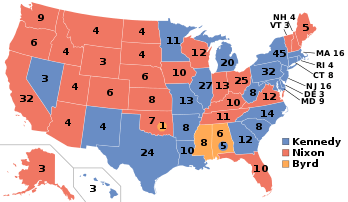  Presidential election results map. Blue denotes states won by Kennedy/Johnson, red denotes those won by Nixon/Lodge, orange denotes the electoral votes for Byrd/Thurmond by Alabama and Mississippi unpledged electors, and a vote for Byrd/Goldwater by an Oklahoma faithless elector. Numbers indicate the number of electoral votes allotted to each state. | |||||||||||||||||||||||||||||
| |||||||||||||||||||||||||||||
Nixon faced little opposition in the Republican race to succeed popular incumbent Dwight D. Eisenhower. Kennedy, a junior U.S. Senator from Massachusetts, established himself as the Democratic front-runner with his strong performance in the 1960 Democratic primaries, including a key victory in West Virginia over United States Senator Hubert Humphrey. He defeated Senate Majority Leader Lyndon B. Johnson on the first presidential ballot of the 1960 Democratic National Convention, and asked Johnson to serve as his running mate. The issue of the Cold War dominated the election, as tensions were high between the United States and the Soviet Union.
Kennedy won a 303 to 219 Electoral College victory and is generally considered to have won the national popular vote by 112,827, a margin of 0.17 percent, though some argue that Nixon should be credited with the popular vote victory,[2] as the issue of the popular vote was complicated by the presence of several unpledged electors in the Deep South. Fourteen unpledged electors from Mississippi and Alabama cast their vote for Senator Harry F. Byrd, as did a faithless elector from Oklahoma. The 1960 presidential election was the closest election since 1916, and this closeness can be explained by a number of factors.[3] Kennedy benefited from the economic recession of 1957–58, which hurt the standing of the incumbent Republican Party, and he had the advantage of 17 million more registered Democrats than Republicans.[4] Furthermore, the new votes that Kennedy, the first Roman Catholic president, gained among Catholics almost neutralized the new votes Nixon gained among Protestants.[5] Kennedy's campaigning skills decisively outmatched Nixon's, who wasted time and resources campaigning in all fifty states while Kennedy focused on campaigning in populous swing states. Nixon's emphasis on his experience carried little weight for most voters. Kennedy used his large, well-funded campaign organization to win the nomination, secure endorsements, and, with the aid of the big-city bosses, get out the vote in the big cities.[6] Kennedy relied on Johnson to hold the South, and used television effectively.
On November 22, 1963, Kennedy was assassinated in Dallas, Texas and was succeeded by Johnson. Nixon would later successfully seek the presidency in 1968, but would resign in August 1974 due to the Watergate scandal; he was succeeded by his Vice President, Gerald Ford.
Nominations
Democratic Party
| Democratic Party Ticket, 1960 | |||||||||||||||||||||||||||||
| John F. Kennedy | Lyndon B. Johnson | ||||||||||||||||||||||||||||
|---|---|---|---|---|---|---|---|---|---|---|---|---|---|---|---|---|---|---|---|---|---|---|---|---|---|---|---|---|---|
| for President | for Vice President | ||||||||||||||||||||||||||||
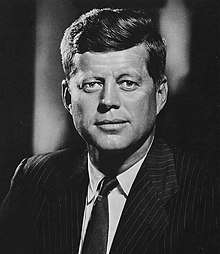 |
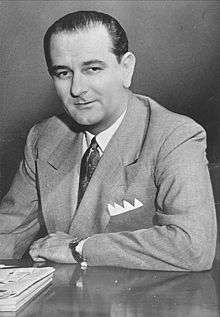 | ||||||||||||||||||||||||||||
| U.S. Senator from Massachusetts (1953–1960) |
U.S. Senator from Texas (1949–1961) | ||||||||||||||||||||||||||||
| Campaign | |||||||||||||||||||||||||||||
 | |||||||||||||||||||||||||||||
Democratic candidates
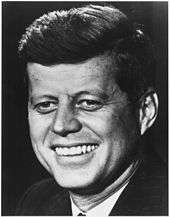 Senator John F. Kennedy from Massachusetts
Senator John F. Kennedy from Massachusetts Senate Majority Leader Lyndon B. Johnson from Texas
Senate Majority Leader Lyndon B. Johnson from Texas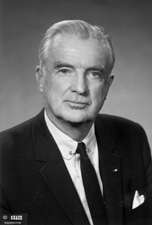 Senator Stuart Symington from Missouri
Senator Stuart Symington from Missouri Senator Hubert Humphrey from Minnesota
Senator Hubert Humphrey from Minnesota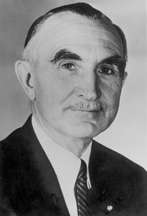 Senator Wayne Morse from Oregon
Senator Wayne Morse from Oregon Senator George Smathers from Florida
Senator George Smathers from Florida
The major candidates for the 1960 Democratic presidential nomination were United States Senator John F. Kennedy from Massachusetts, Governor Pat Brown of California, United States Senator Stuart Symington from Missouri, United States Senator Lyndon B. Johnson from Texas, former Illinois Governor Adlai Stevenson,[7] United States Senator Wayne Morse from Oregon, and United States Senator Hubert Humphrey from Minnesota. Several other candidates sought support in their home state or region as "favorite son" candidates without any realistic chance of winning the nomination. Symington, Stevenson, and Johnson all declined to campaign in the presidential primaries. While this reduced their potential delegate count going into the Democratic National Convention, each of these three candidates hoped that the other leading contenders would stumble in the primaries, thus causing the convention's delegates to choose him as a "compromise" candidate acceptable to all factions of the party.
Kennedy was initially dogged by suggestions from some Democratic Party elders (such as former United States President Harry S. Truman, who was supporting Symington) that he was too youthful and inexperienced to be president; these critics suggested that he should agree to be the running mate for another Democrat. Realizing that this was a strategy touted by his opponents to keep the public from taking him seriously, Kennedy stated frankly, "I'm not running for vice president, I'm running for president."[8]
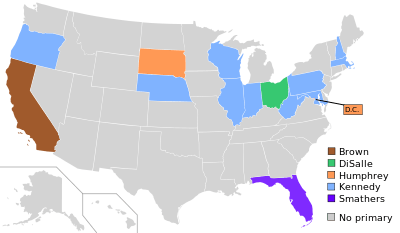
The next step was the primaries. Kennedy's Roman Catholic religion was an issue. Kennedy first challenged Minnesota Senator Hubert Humphrey in the Wisconsin primary and defeated him. Kennedy's sisters, brothers, and wife Jacqueline combed the state looking for votes, leading Humphrey to complain that he "felt like an independent merchant competing against a chain store."[9] However, some political experts argued that Kennedy's margin of victory had come almost entirely from Catholic areas, and thus Humphrey decided to continue the contest in the heavily Protestant state of West Virginia. The first televised debate of 1960 was held in West Virginia, and Kennedy outperformed Humphrey.[10] Humphrey's campaign was low on funds and could not compete for advertising and other "get-out-the-vote" drives with Kennedy's well-financed and well-organized campaign. In the end, Kennedy defeated Humphrey with over 60% of the vote, and Humphrey ended his presidential campaign. West Virginia showed that Kennedy, a Catholic, could win in a heavily Protestant state. Although Kennedy had only competed in nine presidential primaries,[11] Kennedy's rivals, Johnson and Symington, failed to campaign in any primaries. Even though Stevenson had twice been the Democratic Party's presidential candidate and retained a loyal following of liberals, his two landslide defeats to Republican United States President Dwight D. Eisenhower led most party leaders and delegates to search for a "fresh face" who could win a national election. Following the primaries, Kennedy traveled around the nation speaking to state delegations and their leaders. As the Democratic Convention opened, Kennedy was far in the lead, but was still seen as being just short of the delegate total he needed to win.
Democratic convention
The 1960 Democratic National Convention was held in Los Angeles, California. In the week before the convention opened, Kennedy received two new challengers when Lyndon B. Johnson, the powerful Senate Majority Leader from Texas, and Adlai Stevenson, the party's nominee in 1952 and 1956, officially announced their candidacies (they had both privately been working for the nomination for some time). However, neither Johnson nor Stevenson was a match for the talented and highly efficient Kennedy campaign team led by Robert F. Kennedy. Johnson challenged Kennedy to a televised debate before a joint meeting of the Texas and Massachusetts delegations, to which Kennedy accepted. Most observers believed that Kennedy won the debate, and Johnson was unable to expand his delegate support beyond the South. Stevenson's failure to launch his candidacy publicly until the week of the convention meant that many liberal delegates who might have supported him were already pledged to Kennedy, and Stevenson—despite the energetic support of former First Lady Eleanor Roosevelt—could not break their allegiance. Kennedy won the nomination on the first ballot.
Then, in a move that surprised many, Kennedy asked Johnson to be his running mate. He realized that he could not be elected without the support of traditional Southern Democrats, most of whom had backed Johnson. He offered Johnson the vice presidential nomination at the Los Angeles Biltmore Hotel at 10:15 a.m. on July 14, 1960, the morning after being nominated for president.[12] Robert F. Kennedy, who hated Johnson for his attacks on the Kennedy family, and who favored labor leader Walter Reuther,[13] later said that his brother offered the position to Johnson as a courtesy and did not predict him to accept it. Arthur M. Schlesinger Jr., and Seymour Hersh quoted Robert Kennedy's version of events, writing that John Kennedy "would have preferred Stuart Symington as his running-mate" and that Johnson teamed with House Speaker Sam Rayburn to "pressure Kennedy to offer the nomination". Hersh goes on to present an alternative version of events; he writes that Kennedy was essentially blackmailed into offering the vice presidency to Johnson. The same story was originally presented by Anthony Summers in his biography of FBI Director J. Edgar Hoover. Evelyn Lincoln, Kennedy's personal secretary, told Summers in an interview that she was convinced in mid-1960 that J. Edgar Hoover and Johnson had conspired. Hoover was known to keep detailed files on the personal lives of many political figures and Kennedy was no exception. Hoover obtained information about Jack's womanizing prior to the election from at least two different sources. In January 1942, while Jack was serving in the United States Navy, FBI surveillance records confirmed that he was having an affair with a woman named Inga Arvad; then, in 1958, a couple named Leonard and Florence Kater found out that their tenant, Pamela Turnure, a secretary in Kennedy's Senate office, had been having an affair with the soon-to-be president. The Katers rigged up a tape recorder to pick up the sounds of the couple's lovemaking and snapped a picture of Kennedy himself. The Katers sent this information to the newspapers and one company - Stearn Publications - passed it along to Hoover. Soon after, "he quietly obtained a copy of the compromising sex tapes and offered them to Lyndon Johnson as campaign ammunition." Lincoln said that Johnson "had been using all the information Hoover could find on Kennedy - during the campaign, even before the Convention. And Hoover was in on the pressure on Kennedy at the Convention." A few days after the offer was made, Pierre Salinger, the campaign's press secretary, had asked Jack Kennedy whether he really expected Johnson to accept the offer or if he was merely making a polite gesture. Kennedy responded cryptically: "The whole story will never be known. And it's just as well that it won't be." "The only people who were involved in the discussions were Jack and myself," said Robert Kennedy. "We both promised each other that we'd never tell what happened."[14][15]
Biographers Robert Caro and W. Marvin Watson offer a different perspective; they write that the Kennedy campaign was desperate to win what was forecast to be a very close race against Richard Nixon and Henry Cabot Lodge Jr.. Johnson was needed on the ticket to help carry votes from Texas and the Southern United States. Caro's research showed that on July 14, Kennedy started the process while Johnson was still asleep. At 6:30 a.m., Kennedy asked his brother to prepare an estimate of upcoming electoral votes, "including Texas."[12] Robert Kennedy called Pierre Salinger and Kenneth O'Donnell to assist him. Realizing the ramifications of counting Texas votes as their own, Salinger asked him whether he was considering a Kennedy-Johnson ticket, and Robert replied, "yes".[12] Between 9 and 10 a.m., John Kennedy called Pennsylvania governor David L. Lawrence, a Johnson backer, to request that Lawrence nominate Johnson for vice president if Johnson were to accept the role and then went to Johnson's suite to discuss a mutual ticket at 10:15 a.m. John Kennedy then returned to his suite to announce the Kennedy-Johnson ticket to his closest supporters and Northern political bosses. He accepted the congratulations of Ohio Governor Michael DiSalle, Connecticut Governor Abraham A. Ribicoff, Chicago mayor Richard J. Daley, and New York City mayor Robert F. Wagner Jr.. Lawrence said that "Johnson has the strength where you need it most"; he then left to begin writing the nomination speech.[12] O'Donnell remembers being angry at what he considered a betrayal by John Kennedy, who had previously cast Johnson as anti-labor and anti-liberal. Afterward, Robert Kennedy visited with labor leaders who were extremely unhappy with the choice of Johnson and after seeing the depth of labor opposition to Johnson, he ran messages between the hotel suites of his brother and Johnson, apparently trying to undermine the proposed ticket without John Kennedy's authorization and to get Johnson to agree to be the Democratic Party chairman rather than vice president. Johnson refused to accept a change in plans unless it came directly from John Kennedy. Despite his brother's interference, John Kennedy was firm that Johnson was who he wanted as running mate and met with staffers such as Larry O'Brien, his national campaign manager, to say Johnson was to be vice president. O'Brien recalled later that John Kennedy's words were wholly unexpected, but that after a brief consideration of the electoral vote situation, he thought "it was a stroke of genius".[12]
Norman Mailer attended the convention and wrote his famous profile of Kennedy, "Superman Comes to the Supermart," published in Esquire.[16]
Republican Party
| Republican Party ticket, 1960 | |||||||||||||||||||||||||||||
| Richard Nixon | Henry Cabot Lodge Jr. | ||||||||||||||||||||||||||||
|---|---|---|---|---|---|---|---|---|---|---|---|---|---|---|---|---|---|---|---|---|---|---|---|---|---|---|---|---|---|
| for President | for Vice President | ||||||||||||||||||||||||||||
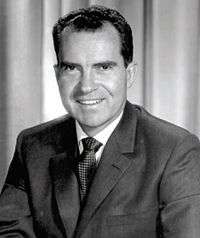 |
_(cropped_3x4).jpg) | ||||||||||||||||||||||||||||
| 36th Vice President of the United States (1953–1961) |
3rd U.S. Ambassador to the UN (1953–1960) | ||||||||||||||||||||||||||||
| Campaign | |||||||||||||||||||||||||||||
 | |||||||||||||||||||||||||||||
Republican candidates
 Vice President Richard Nixon
Vice President Richard Nixon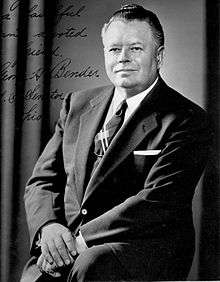 Former Senator George H. Bender from Ohio
Former Senator George H. Bender from Ohio State Senator James M. Lloyd from South Dakota
State Senator James M. Lloyd from South Dakota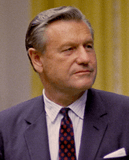 Governor Nelson Rockefeller of New York
Governor Nelson Rockefeller of New York Governor Cecil H. Underwood of West Virginia
Governor Cecil H. Underwood of West Virginia
With the ratification of the 22nd Amendment in 1951, President Dwight D. Eisenhower could not run for the office of president again; he had been elected in 1952 and 1956.
In 1959, it looked as if Vice President Richard Nixon might face a serious challenge for the Republican nomination from New York Governor Nelson Rockefeller, the leader of the Republican moderate-liberal wing. However, Rockefeller announced that he would not be a candidate for president after a national tour revealed that the great majority of Republicans favored Nixon.[17]
After Rockefeller's withdrawal, Nixon faced no significant opposition for the Republican nomination. At the 1960 Republican National Convention in Chicago, Illinois, Nixon was the overwhelming choice of the delegates, with conservative Senator Barry Goldwater from Arizona receiving 10 votes from conservative delegates. In earning the nomination, Nixon became the first sitting vice president to run for president since John C. Breckinridge exactly a century prior. Nixon then chose former Massachusetts Senator and United Nations Ambassador Henry Cabot Lodge Jr., as his vice presidential running mate. Nixon chose Lodge because his foreign-policy credentials fit into Nixon's strategy to campaign more on foreign policy than domestic policy, which he believed favored the Democrats. Nixon had previously sought Rockefeller as his running mate, but the governor had no ambitions to be vice president. However, he later served as Gerald Ford's vice president from 1974 to 1977.[18]
General election
Campaign promises

During the campaign, Kennedy charged that under Eisenhower and the Republicans the nation had fallen behind the Soviet Union in the Cold War, both militarily and economically, and that as president he would "get America moving again." The Eisenhower administration had established NASA in 1958, but Kennedy believed that the Republican Party had ignored the need to catch up to the Soviet Union in the Space Race. He promised that the new Democratic administration would fully appreciate the importance of space accomplishments for the national security and international prestige of the United States. Nixon responded that, if elected, he would continue the "peace and prosperity" that Eisenhower had brought the nation in the 1950s. Nixon also argued that with the nation engaged in the Cold War with the Soviets, that Kennedy was too young and inexperienced to be trusted with the presidency. Had Nixon been elected, at 48 years, 11 days, he would have been the fourth-youngest president at the date of inauguration. Kennedy, by contrast, was 43 years, 236 days, on the date of his inauguration; the second-youngest man to begin a Presidency (at 42 Theodore Roosevelt, who assumed the Presidency upon the assassination of United States President William McKinley 60 years previously, was the youngest).
During Kennedy's campaign he relied on his youth and promised to bring about change. Kennedy had a slogan emphasizing his youth reading, "who's seasoned through and through/but not so dog-gone seasoned that he won't try something new." He was also endorsed by celebrities such as Henry Fonda and Harry Belafonte. Nixon relied on his experience in politics. He emphasized to the American voters that he was more qualified to hold the office of president. He wanted voters to know that he had the abilities to take on Communist threats.[19]
Campaign events
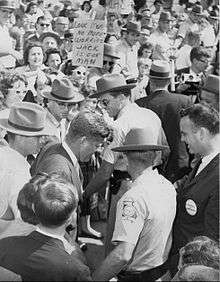
Kennedy and Nixon both drew large and enthusiastic crowds throughout the campaign.[20] In August 1960, most polls gave Nixon a slim lead over Kennedy, and many political pundits regarded him as the favorite to win. However, Nixon was plagued by bad luck throughout the fall campaign. In August, President Eisenhower, who had long been ambivalent about Nixon, held a televised press conference in which a reporter, Charles Mohr of Time, mentioned Nixon's claims that he had been a valuable administration insider and adviser. Mohr asked Eisenhower if he could give an example of a major idea of Nixon's that he had heeded. Eisenhower responded with the flip comment, "If you give me a week, I might think of one."[21] Although both Eisenhower and Nixon later claimed that he was merely joking with the reporter, the remark hurt Nixon, as it undercut his claims of having greater decision-making experience than Kennedy. The remark proved so damaging to Nixon that the Democrats turned Eisenhower's statement into a television commercial.[22]
At the Republican National Convention, Nixon had pledged to campaign in all fifty states. This pledge backfired when, in August, Nixon injured his knee on a car door while campaigning in North Carolina. The knee became infected and Nixon had to cease campaigning for two weeks while the infection was treated with antibiotics. When he left Walter Reed Hospital, Nixon refused to abandon his pledge to visit every state; he thus wound up wasting valuable time visiting states that he had no chance of winning, or that had few electoral votes and would be of little help at the election, or states that he would almost certainly win regardless. For example, in his effort to visit all 50 states, Nixon spent the vital weekend before the election campaigning in Alaska, which had only three electoral votes, while Kennedy campaigned in more populous states, such as New Jersey, Ohio, Michigan, and Pennsylvania.
Nixon visited Atlanta, Georgia on August 26 and acquired a very large turnout to his event. Nixon rode through a parade in Atlanta and was greeted by 150,000 people.[23] Nixon mentioned in his speech in Atlanta, "in the last quarter of a century there hasn't been a Democratic candidate for President that has bothered to campaign in the State of Georgia."[24] However, Kennedy would not let Nixon take the Democratic states that easily. Kennedy would change that statistic and visit some surprising states, including Georgia. Senator Kennedy visited the cities of Columbus, Warm Springs, and Lagrange on his campaign trail in Georgia. In his visit to Warm Springs, state troopers tried to keep Kennedy from an immense crowd, however Kennedy reached out to shake hands of those who were sick with polio.[25] He also visited small towns across Georgia on his trip and saw a mass of 100,000 people during the entire visit. Kennedy spoke at a rehabilitation facility in Warm Springs. Warm Springs was near and dear to Kennedy's heart due to the effects the facility had on Franklin D. Roosevelt. Roosevelt spent time at the rehabilitation facility and died there in 1945.[24]
In Warm Springs, Kennedy spoke to supporters at the facility and mentioned Franklin D. Roosevelt in his speech. He admired Roosevelt and commended him for sticking up for the farmers, workers, small towns, big cities, those in poverty, and those who were sick.[24] He said Roosevelt had a "spirit of strength and progress to get America moving."[24] Kennedy discussed his six-point plan for healthcare. He wanted a medical program set up for retirement and federal funding for the construction of medical schools and hospitals. He also planned for the government to loan students money to attend medical school and provide grants to renovate old hospitals. He called for more money to be spent on medical research and finally, expand effort for rehabilitation and come up with new ways to assist those in need.[24] Many Republicans disapproved Kennedy's plans and described them as an "appeal to socialism".[26] People around Warm Springs were supportive of Kennedy. Women were wearing hats reading, "Kennedy and Johnson".[27] Signs around the town read, "Douglas County For Kennedy Except 17 Republicans 6 Old Grouches".[28] Joe O. Butts, the mayor of Warm Springs during Kennedy's visit, said, "He must've shaken hands with everybody within two miles of him, and he was smiling all the time."[29]
Despite the reservations Robert Kennedy had about Johnson's nomination, choosing Johnson as Kennedy's running mate proved to be a masterstroke. Johnson vigorously campaigned for Kennedy and was instrumental in helping the Democrats to carry several Southern states skeptical of him, especially Johnson's home state of Texas. Johnson made a "last-minute change of plans and scheduled two 12-minute whistlestop speeches in Georgia".[30] One of these visits included stopping in Atlanta to speak from the rear of a train at Terminal Station.[31] On the other hand, Ambassador Lodge, Nixon's running mate, ran a lethargic campaign and made several mistakes that hurt Nixon. Among them was a pledge—not approved by Nixon—that as president, Nixon would name a black person to his cabinet. The remark offended many blacks, who saw it as a clumsy attempt to win their votes.
Debates
There were four presidential debates and no vice presidential debates during the 1960 general election.[32]
| No. | Date | Host | Location | Panelists | Moderator | Participant | Viewership
(Millions) |
|---|---|---|---|---|---|---|---|
| P1 | Monday, September 26, 1960 | WBBM-TV | Chicago, Illinois | Sander Vanocur
Charles Warren |
Howard K. Smith | Senator John F. Kennedy | 66.4[32] |
| P2 | Friday, October 7, 1960 | WRC-TV | Washington, D.C. | Paul Niven
Alan Spivak Harold R. Levy |
Frank McGee | Senator John F. Kennedy | 61.9[32] |
| P3 | Thursday, October 13, 1960 | ABC Studios Los Angeles (Nixon)
ABC Studios New York (Kennedy) |
Los Angeles, California | Frank McGee
Charles Van Fremd Douglass Cater
|
Bill Shadel | Senator John F. Kennedy | 63.7[32] |
| P4 | Friday, October 21, 1960 | ABC Studios New York | New York City, New York | Frank Singiser
John Edwards |
Quincy Howe | Senator John F. Kennedy | 60.4[32] |
.jpg)
The key turning point of the campaign came with the four Kennedy-Nixon debates; they were the first presidential debates ever (The Lincoln–Douglas debates of 1858 had been the first for senators from Illinois), also the first held on television, and thus attracted enormous publicity. Nixon insisted on campaigning until just a few hours before the first debate started. He had not completely recovered from his stay in hospital and thus looked pale, sickly, underweight, and tired.[34] His eyes moved across the room during the debate, and at various moments sweat was visible on his face. He also refused make-up for the first debate, and as a result his facial stubble showed prominently on the black-and-white TV screens at the time. Furthermore, the debate set appeared darker once the paint dried up, causing Nixon's suit color to blend in with the background which reduced his stature.[34] Nixon's poor appearance on television in the first debate is reflected by the fact that his mother called him immediately following the debate to ask if he was sick.[35] Kennedy, by contrast, rested and prepared extensively beforehand, appearing tanned,[lower-alpha 1] confident, and relaxed during the debate.[37] An estimated 70 million viewers watched the first debate.[38]
It is often claimed that people who watched the debate on television overwhelmingly believed Kennedy had won, while radio listeners (a smaller audience) thought Nixon had ended up defeating him.[38] However, that has been disputed.[39] Indeed, one study has speculated that the viewer/listener disagreement could be due to sample bias in that those without TV could be a skewed subset of the population:[40]
Evidence in support of this belief [i.e., that Kennedy's physical appearance overshadowed his performance during the first debate] is mainly limited to sketchy reports about a market survey conducted by Sindlinger & Company in which 49% of those who listened to the debates on radio said Nixon had won compared to 21% naming Kennedy, while 30% of those who watched the debates on television said Kennedy had won compared to 29% naming Nixon. Contrary to popular belief, the Sindlinger evidence suggests not that Kennedy won on television but that the candidates tied on television while Nixon won on radio. However, no details about the sample have ever been reported, and it is unclear whether the survey results can be generalized to a larger population. Moreover, since 87% of American households had a television in 1960 [and that the] fraction of Americans lacking access to television in 1960 was concentrated in rural areas and particularly in southern and western states, places that were unlikely to hold significant proportions of Catholic voters.[37]
After the first debate, polls showed Kennedy moving from a slight deficit into a slight lead over Nixon. For the remaining three debates, Nixon regained his lost weight, wore television makeup, and appeared more forceful than in his initial appearance.
However, up to 20 million fewer viewers watched the three remaining debates than the first. Political observers at the time felt that Kennedy won the first debate,[41] Nixon won the second[42] and third debates,[43] while the fourth debate,[44] which was seen as the strongest performance by both men, was a draw.
The third debate has been notable, as it brought about a change in the debate process. This debate was a monumental step for television. For the first time ever, split-screen technology was used to bring two people from opposite sides of the country together so they were able to converse in real time. Nixon was in Los Angeles while Kennedy was in New York. The men appear to be in the same room, thanks to identical sets. Both candidates had monitors in their respective studios containing the feed from the opposite studio so they could respond to questions. Bill Shadel moderated the debate from a third television studio in Chicago. The main topic of this debate was whether military force should be used to prevent Quemoy and Matsu, two island archipelagos off the Chinese coast, from falling under Communist control.[45][46]
Campaign issues
A key concern in Kennedy's campaign was the widespread skepticism among Protestants about his Roman Catholic religion. Some Protestants, especially Southern Baptists and Lutherans, feared that having a Catholic in the White House would give undue influence to the Pope in the nation's affairs.[47] Radio evangelists such as G. E. Lowman wrote that, "Each person has the right to their own religious belief ... [but] ... the Roman Catholic ecclesiastical system demands the first allegiance of every true member and says in a conflict between church and state, the church must prevail".[48] The religious issue was so significant that Kennedy made a speech before the nation's newspaper editors in which he criticized the prominence they gave to the religious issue over other topics – especially in foreign policy – that he felt were of greater importance.[49]
To address fears among Protestants that his Roman Catholicism would impact his decision-making, Kennedy told the Greater Houston Ministerial Association on September 12, 1960, "I am not the Catholic candidate for president. I am the Democratic Party's candidate for president who also happens to be a Catholic. I do not speak for my Church on public matters – and the Church does not speak for me."[50] He promised to respect the separation of church and state and not to allow Catholic officials to dictate public policy to him. Kennedy also raised the question of whether one-quarter of Americans were relegated to second-class citizenship just because they were Roman Catholic. Kennedy would become the first, and, as of 2020, only Roman Catholic to be elected president.[51]
Kennedy's campaign took advantage of an opening when Rev. Martin Luther King Jr., the civil-rights leader, was arrested in Georgia while taking part in a sit-in.[52] Nixon asked President Dwight D. Eisenhower to pardon King, but the President declined to do so. Nixon refused to take further action, but Kennedy placed calls to local political authorities to get King released from jail, and he also called King's father and wife. As a result, King's father endorsed Kennedy, and he received much favorable publicity in the black community. A letter to the Governor of Georgia regarding Martin Luther King Jr.'s arrest also helped Kennedy garner many African American votes. John F. Kennedy asked Governor Ernest Vandiver to look into the harsh sentencing and stated his claim that he did not want to have to get involved in Georgia's justice system.[53] A member of Kennedy's civil rights team and King's friend, Harris Wofford, and other Kennedy campaign members passed out a pamphlet to black churchgoers the Sunday before the presidential election that said, ""No Comment" Nixon versus a Candidate with a Heart, Senator Kennedy.""[54] On election day, Kennedy won the black vote in most areas by wide margins, and this may have provided his margin of victory in states such as New Jersey, South Carolina, Illinois, and Missouri. Researchers found that Kennedy's appeal to African American voters appears to be largely responsible for his receiving more African-American votes than Adlai Stevenson in the 1956 election. The same study conducted found that white voters were less influenced on the topic of civil rights than black voters in 1960. The Republican national chairman at the time, Thruston Ballard Morton, regarded the African-American vote as the single most crucial factor.[55]
The issue that dominated the election was the rising Cold War tensions between the United States and the Soviet Union.[56] In 1957, the Soviets had launched Sputnik, the first man-made satellite to orbit Earth.[56] Soon afterwards, some American leaders warned that the nation was falling behind communist countries in science and technology.[56] In Cuba, the revolutionary regime of Fidel Castro, became a close ally of the Soviet Union in 1960, heightening fears of communist subversion in the Western Hemisphere.[56] Public opinion polls revealed that more than half the American people thought war with the Soviet Union was inevitable.[56]
Kennedy took advantage of increased Cold War tension by emphasizing a perceived "missile gap" between the United States and Soviet Union. He argued that under the Republicans the Soviets had developed a major advantage in the numbers of nuclear missiles.[57] He proposed a bipartisan congressional investigation about the possibility that the Soviet Union was ahead of the United States in developing missiles.[29] He also noted in an October 18 speech that several senior US military officers had long criticized the Eisenhower Administration's defense spending policies.[58]
Both candidates also argued about the economy and ways in which they could increase the economic growth and prosperity of the 1950s and make it accessible to more people (especially minorities). Some historians criticize Nixon for not taking greater advantage of Eisenhower's popularity (which was around 60–65% throughout 1960 and on election day) and for not discussing the prosperous economy of the Eisenhower presidency more often in his campaign.[59] As the campaign moved into the final two weeks, the polls and most political pundits predicted a Kennedy victory. However, President Eisenhower, who had largely sat out the campaign, made a vigorous campaign tour for Nixon over the last 10 days before the election. Eisenhower's support gave Nixon a badly needed boost. Nixon also criticized Kennedy for stating that Quemoy and Matsu, two small islands off the coast of Communist China that were held by Nationalist Chinese forces based in Taiwan, were outside the treaty of protection the United States had signed with the Nationalist Chinese. Nixon claimed the islands were included in the treaty and accused Kennedy of showing weakness towards Communist aggression.[60] Aided by the Quemoy and Matsu issue, and by Eisenhower's support, Nixon began to gain momentum and by election day the polls indicated a virtual tie.
Results


The election was held on November 8, 1960. Nixon watched the election returns from his suite at the Ambassador Hotel in Los Angeles, while Kennedy watched them at the Kennedy Compound in Hyannis Port, Massachusetts. As the early returns poured in from large Northeastern and Midwestern cities, such as Boston, New York City, Philadelphia, Pittsburgh, Cleveland, Detroit, and Chicago, Kennedy opened a large lead in the popular and electoral votes, and appeared headed for victory. However, as later returns came in from rural and suburban areas in the Midwest, the Rocky Mountain states and the Pacific Coast states, Nixon began to steadily close the gap on Kennedy.[61]
Before midnight, The New York Times had gone to press with the headline "Kennedy Elected President". As the election again became too close to call, Times managing editor Turner Catledge hoped that, as he recalled in his memoirs, "a certain Midwestern mayor would steal enough votes to pull Kennedy through", thus allowing the Times to avoid the embarrassment of announcing the wrong winner, as the Chicago Tribune had memorably done twelve years earlier in announcing that Thomas E. Dewey had defeated President Truman.[62]
Nixon made a speech at about 3 a.m., and hinted that Kennedy might have won the election. News reporters were puzzled, as it was not a formal concession speech. It was not until the afternoon of the next day that Nixon finally conceded the election, and Kennedy claimed his victory.
Of the 3,129 counties and independent cities making returns, Nixon won in 1,857 (59.35%) while Kennedy carried 1,200 (38.35%). "Unpledged" electors came first in 71 counties (2.27%) throughout Louisiana and Mississippi, and one county (0.03%) in Alaska split evenly between Kennedy and Nixon.

A sample of how close the election was can be seen in California, Nixon's home state. Kennedy seemed to have carried the state by 37,000 votes when all of the voting precincts reported, but when the absentee ballots were counted a week later, Nixon came from behind to win the state by 36,000 votes.[63] Similarly, in Hawaii, it appeared as though Nixon had won there (it was actually called for him early Wednesday morning), but in a recount, Kennedy was able to come from behind and win the state by an extremely narrow margin of 115 votes.
In the national popular vote, Kennedy beat Nixon by less than two tenths of one percentage point (0.17%), the closest popular-vote margin of the 20th century. So close was the popular vote that a shift of 18,858 votes in Illinois and Missouri, both won by Kennedy by less than 1%, would have left both Kennedy and Nixon short of the 269 electoral votes required to win, thus forcing a contingent election in the House of Representatives.
In the Electoral College, Kennedy's victory was larger, as he took 303 electoral votes to Nixon's 219. A total of 15 electors, eight from Mississippi, six from Alabama, and one from Oklahoma all refused to vote for either Kennedy or Nixon, and instead cast their votes for Senator Harry F. Byrd of Virginia, a conservative Democrat, even though he had not been a candidate for president.[64] Kennedy carried 12 states by three percentage points or less, while Nixon won six by similarly narrow margins. Kennedy carried all but three states in the populous Northeast, and he also carried the large states of Michigan, Illinois, and Missouri in the Midwest. With Lyndon Johnson's help, he also carried most of the South, including the large states of North Carolina, Georgia, and Texas. Nixon carried all but three of the Western states (including California), and he ran strong in the farm belt states, where his biggest victory was in Ohio.
The New York Times, summarizing the discussion in late November, spoke of a "narrow consensus" among the experts that Kennedy had won more than he lost "as a result of his Catholicism",[65] as Northern Catholics flocked to Kennedy because of attacks on his religion. Interviewing people who voted in both 1956 and 1960, a University of Michigan team analyzing the election returns discovered that people who voted Democratic in 1956 split 33–6 for Kennedy, while the Republican voters of 1956 split 44–17 for Nixon. That is, Nixon lost 28% (17/61) of the Eisenhower voters, while Kennedy lost only 15% of the Stevenson voters. The Democrats, in other words, did a better job of holding their 1956 supporters.[66]
Kennedy said that he saw the challenges ahead and needed the country's support to get through them. In his victory speech, he declared, "To all Americans, I say that the next four years are going to be difficult and challenging years for us all; that a supreme national effort will be needed to move this country safely through the 1960s. I ask your help and I can assure you that every degree of my spirit that I possess will be devoted to the long-range interest of the United States and to the cause of freedom around the world."[67]
Controversies
Some, including Republican legislators and journalists, believed that Kennedy benefited from vote fraud, especially in Texas, where his running mate Lyndon B. Johnson was senator, and Illinois, home of Mayor Richard Daley's powerful Chicago political machine.[63] These two states were important because if Nixon had carried both, he would have earned 270 electoral votes, one more than the 269 needed to win the majority in the Electoral College and the presidency. Republican senators such as Everett Dirksen and Barry Goldwater also thought that vote fraud "played a role in the election",[62] and that Nixon actually won the national popular vote. Republicans tried and failed to overturn the results in both Illinois and Texas at the time, as well as in nine other states.[68] Some journalists also later claimed that mobster Sam Giancana and his Chicago crime syndicate "played a role" in Kennedy's victory in Illinois.[68]
Nixon's campaign staff urged him to pursue recounts and challenge the validity of Kennedy's victory in several states, especially in Illinois, Missouri, and New Jersey, where large majorities in Catholic precincts handed Kennedy the election.[62] However, Nixon gave a speech three days after the election stating that he would not contest the election.[62] The Republican National Chairman, Senator Thruston Ballard Morton of Kentucky, visited Key Biscayne, Florida, where Nixon had taken his family for a vacation, and pushed for a recount.[62] Morton did challenge the results in 11 states,[63] keeping challenges in the courts into mid-1961; however, the only result of these challenges was the loss of Hawaii to Kennedy on a recount.
Kennedy won Illinois by less than 9,000 votes out of 4.75 million cast, or a margin of 0.2%.[63] However, Nixon carried 92 of the state's 101 counties. Kennedy's victory in Illinois came from the city of Chicago, which boasted favorable demographics for the Democrat, with its large populations of Catholic and African-American voters.[69] His victory margin in the city was 318,736 and 456,312 in Cook County. A myth arose that Chicago Mayor Richard J. Daley held back much of the city's vote until the late morning hours of November 9. Yet when the Republican Chicago Tribune went to press, 79 percent of Cook County precincts had reported, compared with just 62 percent of Illinois's precincts overall. Moreover, Nixon never led in Illinois, and Kennedy's lead merely shrank as election night went on.[69] Earl Mazo, a reporter for the pro-Nixon New York Herald Tribune and his biographer, investigated the voting in Chicago and "claimed to have discovered sufficient evidence of vote fraud to prove that the state was stolen for Kennedy."[63]
In Texas, Kennedy defeated Nixon by a 51 to 49% margin, or 46,000 votes.[63] Some Republicans argued that Johnson's formidable political machine had stolen enough votes in counties along the Mexican border to give Kennedy the victory. Kennedy's defenders, such as his speechwriter and special assistant Arthur M. Schlesinger, Jr., have argued that Kennedy's margin in Texas was simply too large for vote fraud to have been a decisive factor. Russell D. Renka, a former political science professor at Southeastern Missouri State University,[70] acknowledged that it was more than likely that Johnson's political machine in the state's lower Rio Grande Valley counties, including the notorious Duval County, could have "managed to produce a significant number of forged votes" for Kennedy.[71] However, Renka also acknowledged that Kennedy's margin in the state's initial tally "made it far too difficult to prove that voter fraud had determined who won Texas" and that "any recount would also have been hard to conduct."[71]
Allegations of voter fraud were made in Texas. For example, Fannin County had only 4,895 registered voters, yet 6,138 votes were cast in that county, three-quarters for Kennedy.[62] In an Angelina County precinct, Kennedy received 187 votes to Nixon's 24, though there were only a total of 86 registered voters in the precinct.[62] When Republicans demanded a statewide recount, they learned that the state Board of Elections, whose members were all Democrats, had already "certified" Kennedy as the official winner in Texas.[62] This analysis, though, is flawed as the fact was registered voter figures only measured individuals who had paid the poll tax, and that certain groups were exempt from having to pay that tax.[72]
In Illinois, Schlesinger and others have pointed out that, even if Nixon had carried Illinois, the state alone would not have given him the victory, as Kennedy would still have won 276 electoral votes to Nixon's 246 (with 269 needed to win). More to the point, Illinois was the site of the most extensive challenge process, which fell short despite repeated efforts spearheaded by Cook County state's attorney, Benjamin Adamowski, a Republican, who also lost his re-election bid. Despite demonstrating net errors favoring both Nixon and Adamowski (some precincts—40% in Nixon's case—showed errors favoring them, a factor suggesting error, rather than fraud), the totals found fell short of reversing the results for either candidate. While a Daley-connected circuit judge, Thomas Kluczynski (who would later be appointed a federal judge by Kennedy, at Daley's recommendation), threw out a federal lawsuit "filed to contend" the voting totals,[62] the Republican-dominated State Board of Elections unanimously rejected the challenge to the results. Furthermore, there were signs of possible irregularities in downstate areas controlled by Republicans, which Democrats never seriously pressed, since the Republican challenges went nowhere.[73] More than a month after the election, the Republican National Committee abandoned its Illinois voter fraud claims.[63]
However, a special prosecutor assigned to the case brought charges against 650 people, which did not result in convictions.[62] Three Chicago election workers were convicted of voter fraud in 1962 and served short terms in jail.[62] Mazo, the Herald-Tribune reporter, later said that he "found names of the dead who had voted in Chicago, along with 56 people from one house."[62] He found cases of Republican voter fraud in southern Illinois, but said that the totals "did not match the Chicago fraud he found."[62] After Mazo had published four parts of an intended 12-part voter fraud series documenting his findings, which was re-published nationally, he said, "Nixon requested his publisher stop the rest of the series so as to prevent a constitutional crisis."[62] Nevertheless, the Chicago Tribune (which routinely endorsed GOP presidential candidates, including Nixon in 1960, 1968 and 1972) wrote that "the election of November 8 was characterized by such gross and palpable fraud as to justify the conclusion that [Nixon] was deprived of victory."[62]
Popular votes
Alabama
The actual number of popular votes received by Kennedy in Alabama is difficult to determine because of the unusual situation in that state. Instead of having the voters choose from slates of electors, the Alabama ballot had voters choose the electors individually. Traditionally, in such a situation, a given candidate is assigned the popular vote of the elector who received the most votes. For instance, candidates pledged to Nixon received anywhere from 230,951 votes (for George Witcher) to 237,981 votes (for Cecil Durham); Nixon is therefore assigned 237,981 popular votes from Alabama.
The situation was more complicated on the Democratic side. The statewide Democratic primary had chosen eleven candidates for the Electoral College, five of whom were pledged to vote for Kennedy, and six of whom were free to vote for anyone they chose. All of these candidates won in the general election, and all six unpledged electors voted against Kennedy. The actual number of popular votes received by Kennedy is therefore difficult to allocate. Traditionally, Kennedy is assigned either 318,303 votes (the votes won by the most popular Kennedy elector) or 324,050 votes (the votes won by the most popular unpledged Democratic elector); the results table below is based on Kennedy winning 318,303 votes in Alabama.[74]
Georgia
The actual number of popular votes received by Kennedy and Nixon in Georgia is also difficult to determine because voters voted for 12 separate electors.[75] The vote totals of 458,638 votes for Kennedy and 274,472 votes for Nixon reflect the number of votes for the Kennedy and Nixon electors who received the highest number of votes. However, the Republican and Democratic electors receiving the highest number of votes were outliers from the other 11 electors from their party. The average vote totals for the 12 electors were 455,629 votes for the Democratic electors and 273,110 votes for the Republican electors. This shrinks Kennedy's election margin in Georgia by 1,647 votes to 182,519.[76]
Unpledged Democratic electors
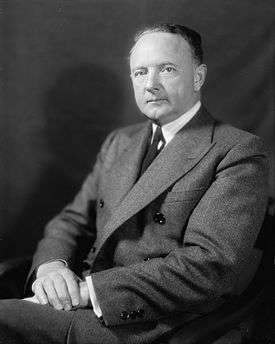
Many Southern Democrats were opposed to voting rights for African Americans living in the South. There was a call from segregationists for electoral votes to be withheld or to be cast for Virginia senator Harry F. Byrd, a segregationist Democrat, as an independent candidate.[77] Both before and after the convention, they attempted to put unpledged Democratic electors on their states' ballots in the hopes of influencing the race; the existence of such electors might influence which candidate would be chosen by the national convention, and, in a close race, such electors might be in a position to extract concessions from either the Democratic or Republican presidential candidates in return for their electoral votes.
Most of these attempts failed. Alabama put up a mixed slate of five loyal electors and six unpledged electors. Mississippi put up two distinct slates, one of loyalists and one of unpledged electors. Louisiana also put up two distinct slates, although the unpledged slate did not receive the "Democratic" label. Georgia freed its Democratic electors from pledges to vote for Kennedy. Governor Ernest Vandiver supported the unpledged electoral votes. Former governor Ellis Arnall did not support the unpledged electoral votes. Arnall called Vandiver's stand "utterly disgraceful."[78]
In total, 14 unpledged Democratic electors won election from the voters. Because electors pledged to Kennedy had won a clear majority of the Electoral College, the unpledged electors could not influence the results. Nonetheless, they refused to vote for Kennedy. Instead, they voted for Byrd, even though he was not an announced candidate and did not seek their votes. In addition, Byrd received one electoral vote from a faithless Oklahoma elector for a total of 15 electoral votes. The faithless Oklahoma elector voted for Barry Goldwater as vice president; the other 14 voted for Strom Thurmond as vice president.
| Presidential candidate | Party | Home state | Popular vote | Electoral vote |
Running mate | |||
|---|---|---|---|---|---|---|---|---|
| Count | Percentage | Vice-presidential candidate | Home state | Electoral vote | ||||
| John Fitzgerald Kennedy | Democratic | Massachusetts | 34,220,984(a) | 49.72% | 303 | Lyndon Baines Johnson | Texas | 303 |
| Richard Milhous Nixon | Republican | California | 34,108,157 | 49.55% | 219 | Henry Cabot Lodge Jr. | Massachusetts | 219 |
| Harry Flood Byrd | Democratic | Virginia | —(b) | —(b) | 15 | James Strom Thurmond Sr. | South Carolina | 14 |
| Barry Morris Goldwater(c) | Arizona | 1(c) | ||||||
| (unpledged electors) | Democratic | (n/a) | 610,409 | 0.42% | —(d) | (n/a) | (n/a) | —(d) |
| Eric Hass | Socialist Labor | New York | 47,522 | 0.07% | 0 | Georgia Cozzini | Wisconsin | 0 |
| Rutherford L. Decker | Prohibition | Missouri | 46,203 | 0.07% | 0 | E. Harold Munn | Michigan | 0 |
| Orval Faubus | States' Rights | Arkansas | 44,984 | 0.07% | 0 | John G. Crommelin | Alabama | 0 |
| Farrell Dobbs | Socialist Workers | New York | 40,175 | 0.06% | 0 | Myra Tanner Weiss | New York | 0 |
| Charles Sullivan | Constitution | Mississippi | (TX) 18,162 | 0.03% | 0 | Merritt Curtis | California | 0 |
| J. Bracken Lee | Conservative | Utah | (NJ) 8,708 | 0.01% | 0 | Kent Courtney | Louisiana | 0 |
| Other | 11,128 | 0.02% | — | Other | — | |||
| Total | 68,832,482 | 100% | 537 | 537 | ||||
| Needed to win | 269 | 269 | ||||||
There were 537 electoral votes, up from 531 in 1956, because of the addition of two U.S. senators and one U.S. representative from each of the new states of Alaska and Hawaii. (The House of Representatives was temporarily expanded from 435 members to 437 to accommodate this, and went back to 435 when reapportioned according to the 1960 census. The reapportionment did not take place until after the 1960 election.)
Source (Popular Vote):Leip, David. "1960 Presidential Election Results". Dave Leip's Atlas of U.S. Presidential Elections. Retrieved February 18, 2012.Note: Sullivan / Curtis ran only in Texas. In Washington, Constitution Party ran Curtis for president and B. N. Miller for vice president, receiving 1,401 votes. Source (Electoral Vote): "Electoral College Box Scores 1789–1996". National Archives and Records Administration. Retrieved August 2, 2005.
- (a) This figure is problematic; see Alabama popular vote above.
- (b) Byrd was not directly on the ballot. Instead, his electoral votes came from unpledged Democratic electors and a faithless elector.
- (c) Oklahoma faithless elector Henry D. Irwin, though pledged to vote for Richard Nixon and Henry Cabot Lodge Jr., instead voted for non-candidate Harry F. Byrd. However, unlike other electors who voted for Byrd and Strom Thurmond as vice president, Irwin cast his vice presidential electoral vote for Arizona Republican Senator Barry Goldwater.
- (d) In Mississippi, the slate of unpledged Democratic electors won. They cast their 8 votes for Byrd and Thurmond.
Geography of results
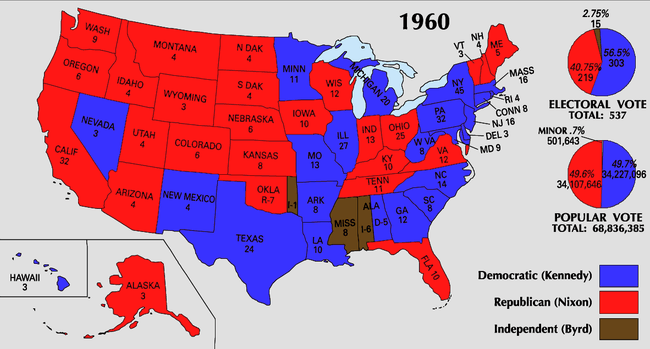
 Results by county, shaded according to winning candidate's percentage of the vote
Results by county, shaded according to winning candidate's percentage of the vote
Cartographic Gallery
 Presidential election results by county
Presidential election results by county Democratic presidential election results by county
Democratic presidential election results by county Republican presidential election results by county
Republican presidential election results by county Unpledged Electors presidential election results by county
Unpledged Electors presidential election results by county "Other" presidential election results by county
"Other" presidential election results by county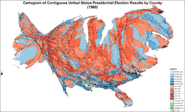 Cartogram of presidential election results by county
Cartogram of presidential election results by county Cartogram of Democratic presidential election results by county
Cartogram of Democratic presidential election results by county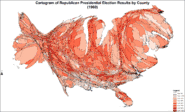 Cartogram of Republican presidential election results by county
Cartogram of Republican presidential election results by county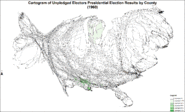 Cartogram of Unpledged Electors presidential election results by county
Cartogram of Unpledged Electors presidential election results by county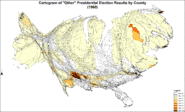 Cartogram of "Other" presidential election results by county
Cartogram of "Other" presidential election results by county
Results by state
| States won by Kennedy/Johnson |
| States won by Nixon/Lodge |
| States won by Unpledged Electors |
| John F. Kennedy Democratic |
Richard Nixon Republican |
Unpledged Electors Unpledged Democratic |
Eric Hass Socialist Labor |
Margin | State Total | ||||||||||||
|---|---|---|---|---|---|---|---|---|---|---|---|---|---|---|---|---|---|
| State | electoral votes |
# | % | electoral votes |
# | % | electoral votes |
# | % | electoral votes |
# | % | electoral votes |
# | % | # | |
| Alabama | 11 | 318,303 | 56.39 | 5 | 237,981 | 42.16 | – | 324,050 | 0.00 | 6 | – | – | – | 80,322 | 14.23 | 564,478 | AL |
| Alaska | 3 | 29,809 | 49.06 | – | 30,953 | 50.94 | 3 | – | – | – | – | – | – | −1,144 | −1.88 | 60,762 | AK |
| Arizona | 4 | 176,781 | 44.36 | – | 221,241 | 55.52 | 4 | – | – | – | 469 | 0.12 | – | −44,460 | −11.16 | 398,491 | AZ |
| Arkansas | 8 | 215,049 | 50.19 | 8 | 184,508 | 43.06 | – | – | – | – | – | – | – | 30,541 | 7.13 | 428,509 | AR |
| California | 32 | 3,224,099 | 49.55 | – | 3,259,722 | 50.10 | 32 | – | – | – | 1,051 | 0.02 | – | −35,623 | −0.55 | 6,506,578 | CA |
| Colorado | 6 | 330,629 | 44.91 | – | 402,242 | 54.63 | 6 | – | – | – | 2,803 | 0.38 | – | −71,613 | −9.73 | 736,246 | CO |
| Connecticut | 8 | 657,055 | 53.73 | 8 | 565,813 | 46.27 | – | – | – | – | – | – | – | 91,242 | 7.46 | 1,222,883 | CT |
| Delaware | 3 | 99,590 | 50.63 | 3 | 96,373 | 49.00 | – | – | – | – | 82 | 0.04 | – | 3,217 | 1.64 | 196,683 | DE |
| Florida | 10 | 748,700 | 48.49 | – | 795,476 | 51.51 | 10 | – | – | – | – | – | – | −46,776 | −3.03 | 1,544,176 | FL |
| Georgia | 12 | 458,638 | 62.54 | 12 | 274,472 | 37.43 | – | – | – | – | – | – | – | 184,166 | 25.11 | 733,349 | GA |
| Hawaii | 3 | 92,410 | 50.03 | 3 | 92,295 | 49.97 | – | – | – | – | – | – | – | 115 | 0.06 | 184,705 | HI |
| Idaho | 4 | 138,853 | 46.22 | – | 161,597 | 53.78 | 4 | – | – | – | – | – | – | −22,744 | −7.57 | 300,450 | ID |
| Illinois | 27 | 2,377,846 | 49.98 | 27 | 2,368,988 | 49.80 | – | – | – | – | 10,560 | 0.22 | – | 8,858 | 0.19 | 4,757,409 | IL |
| Indiana | 13 | 952,358 | 44.60 | – | 1,175,120 | 55.03 | 13 | – | – | – | 1,136 | 0.05 | – | −222,762 | −10.43 | 2,135,360 | IN |
| Iowa | 10 | 550,565 | 43.22 | – | 722,381 | 56.71 | 10 | – | – | – | 230 | 0.02 | – | −171,816 | −13.49 | 1,273,810 | IA |
| Kansas | 8 | 363,213 | 39.10 | – | 561,474 | 60.45 | 8 | – | – | – | – | – | – | −198,261 | −21.35 | 928,825 | KS |
| Kentucky | 10 | 521,855 | 46.41 | – | 602,607 | 53.59 | 10 | – | – | – | – | – | – | −80,752 | −7.18 | 1,124,462 | KY |
| Louisiana | 10 | 407,339 | 50.42 | 10 | 230,980 | 28.59 | – | 169,572 | 20.99 | – | – | – | – | 176,359 | 21.83 | 807,891 | LA |
| Maine | 5 | 181,159 | 42.95 | – | 240,608 | 57.05 | 5 | – | – | – | – | – | – | −59,449 | −14.10 | 421,767 | ME |
| Maryland | 9 | 565,808 | 53.61 | 9 | 489,538 | 46.39 | – | – | – | – | – | – | – | 76,270 | 7.23 | 1,055,349 | MD |
| Massachusetts | 16 | 1,487,174 | 60.22 | 16 | 976,750 | 39.55 | – | – | – | – | 3,892 | 0.16 | – | 510,424 | 20.67 | 2,469,480 | MA |
| Michigan | 20 | 1,687,269 | 50.85 | 20 | 1,620,428 | 48.84 | – | 539 | 0.02 | – | 1,718 | 0.05 | – | 66,841 | 2.01 | 3,318,097 | MI |
| Minnesota | 11 | 779,933 | 50.58 | 11 | 757,915 | 49.16 | – | – | – | – | 962 | 0.06 | – | 22,018 | 1.43 | 1,541,887 | MN |
| Mississippi | 8 | 108,362 | 36.34 | – | 73,561 | 24.67 | – | 116,248 | 38.99 | 8 | – | – | – | −7,886 | −2.64 | 298,171 | MS |
| Missouri | 13 | 972,201 | 50.26 | 13 | 962,221 | 49.74 | – | – | – | – | – | – | – | 9,980 | 0.52 | 1,934,422 | MO |
| Montana | 4 | 134,891 | 48.60 | – | 141,841 | 51.10 | 4 | – | – | – | – | – | – | −6,950 | −2.50 | 277,579 | MT |
| Nebraska | 6 | 232,542 | 37.93 | – | 380,553 | 62.07 | 6 | – | – | – | – | – | – | −148,011 | −24.14 | 613,095 | NE |
| Nevada | 3 | 54,880 | 51.16 | 3 | 52,387 | 48.84 | – | – | – | – | – | – | – | 2,493 | 2.32 | 107,267 | NV |
| New Hampshire | 4 | 137,772 | 46.58 | – | 157,989 | 53.42 | 4 | – | – | – | – | – | – | −20,217 | −6.84 | 295,761 | NH |
| New Jersey | 16 | 1,385,415 | 49.96 | 16 | 1,363,324 | 49.16 | – | – | – | – | 4,262 | 0.15 | – | 22,091 | 0.80 | 2,773,111 | NJ |
| New Mexico | 4 | 156,027 | 50.15 | 4 | 153,733 | 49.41 | – | – | – | – | 570 | 0.18 | – | 2,294 | 0.74 | 311,107 | NM |
| New York | 45 | 3,830,085 | 52.53 | 45 | 3,446,419 | 47.27 | – | – | – | – | – | – | – | 383,666 | 5.26 | 7,291,079 | NY |
| North Carolina | 14 | 713,136 | 52.11 | 14 | 655,420 | 47.89 | – | – | – | – | – | – | – | 57,716 | 4.22 | 1,368,556 | NC |
| North Dakota | 4 | 123,963 | 44.52 | – | 154,310 | 55.42 | 4 | – | – | – | – | – | – | −30,347 | −10.90 | 278,431 | ND |
| Ohio | 25 | 1,944,248 | 46.72 | – | 2,217,611 | 53.28 | 25 | – | – | – | – | – | – | −273,363 | −6.57 | 4,161,859 | OH |
| Oklahoma | 8 | 370,111 | 40.98 | – | 533,039 | 59.02 | 7 | 0 | 0.00 | 1 | – | – | – | −162,928 | −18.04 | 903,150 | OK |
| Oregon | 6 | 367,402 | 47.32 | – | 408,060 | 52.56 | 6 | – | – | – | – | – | – | −40,658 | −5.24 | 776,421 | OR |
| Pennsylvania | 32 | 2,556,282 | 51.06 | 32 | 2,439,956 | 48.74 | – | – | – | – | 7,185 | 0.14 | – | 116,326 | 2.32 | 5,006,541 | PA |
| Rhode Island | 4 | 258,032 | 63.63 | 4 | 147,502 | 36.37 | – | – | – | – | – | – | – | 110,530 | 27.26 | 405,535 | RI |
| South Carolina | 8 | 198,129 | 51.24 | 8 | 188,558 | 48.76 | – | – | – | – | – | – | – | 9,571 | 2.48 | 386,688 | SC |
| South Dakota | 4 | 128,070 | 41.79 | – | 178,417 | 58.21 | 4 | – | – | – | – | – | – | −50,347 | −16.43 | 306,487 | SD |
| Tennessee | 11 | 481,453 | 45.77 | – | 556,577 | 52.92 | 11 | – | – | – | – | – | – | −75,124 | −7.14 | 1,051,792 | TN |
| Texas | 24 | 1,167,567 | 50.52 | 24 | 1,121,310 | 48.52 | – | – | – | – | – | – | – | 46,257 | 2.00 | 2,311,084 | TX |
| Utah | 4 | 169,248 | 45.17 | – | 205,361 | 54.81 | 4 | – | – | – | – | – | – | −36,113 | −9.64 | 374,709 | UT |
| Vermont | 3 | 69,186 | 41.35 | – | 98,131 | 58.65 | 3 | – | – | – | – | – | – | −28,945 | −17.30 | 167,324 | VT |
| Virginia | 12 | 362,327 | 46.97 | – | 404,521 | 52.44 | 12 | – | – | – | 397 | 0.05 | – | −42,194 | −5.47 | 771,449 | VA |
| Washington | 9 | 599,298 | 48.27 | – | 629,273 | 50.68 | 9 | – | – | – | 10,895 | 0.88 | – | −29,975 | −2.41 | 1,241,572 | WA |
| West Virginia | 8 | 441,786 | 52.73 | 8 | 395,995 | 47.27 | – | – | – | – | – | – | – | 45,791 | 5.47 | 837,781 | WV |
| Wisconsin | 12 | 830,805 | 48.05 | – | 895,175 | 51.77 | 12 | – | – | – | 1,310 | 0.08 | – | −64,370 | −3.72 | 1,729,082 | WI |
| Wyoming | 3 | 63,331 | 44.99 | – | 77,451 | 55.01 | 3 | – | – | – | – | – | – | −14,120 | −10.03 | 140,782 | WY |
| TOTALS: | 537 | 34,220,984 | 49.72 | 303 | 34,108,157 | 49.55 | 219 | 610,409 | 0.42 | 15 | 47,522 | 0.07 | – | 112,827 | 0.16 | 68,832,482 | US |
Close states
Margin of victory less than 1% (95 electoral votes):
- Hawaii, 0.06%
- Illinois, 0.19%
- Missouri, 0.52% (tipping point state for Kennedy win)
- California, 0.55%
- New Mexico, 0.74%
- New Jersey, 0.80% (tipping point state for Nixon win)
Margin of victory less than 5% (161 electoral votes):
- Minnesota, 1.43%
- Delaware, 1.64%
- Alaska, 1.88%
- Texas, 2.00%
- Michigan, 2.01%
- Nevada, 2.32%
- Pennsylvania, 2.32%
- Washington, 2.41%
- South Carolina, 2.48%
- Montana, 2.50%
- Mississippi, 2.64%
- Florida, 3.03%
- Wisconsin, 3.72%
- North Carolina, 4.22%
Margin of victory over 5%, but under 10% (160 electoral votes):
- Oregon, 5.24%
- New York, 5.26%
- West Virginia, 5.46%
- Virginia, 5.47%
- Ohio, 6.56%
- New Hampshire, 6.84%
- Arkansas, 7.13%
- Tennessee, 7.15%
- Kentucky, 7.18%
- Maryland, 7.22%
- Connecticut, 7.46%
- Idaho, 7.56%
- Utah, 9.64%
- Colorado, 9.73%
Electoral milestones
- This is the only presidential election where no candidate succeeded in carrying every single county or parish in any state.
- This was the first election where the winning candidate received a majority of the electoral votes although the second-place candidate carried a majority of the states. As of 2016, it has happened once more, in 1976.
- Even though the vote in both Alaska and Hawaii was very close in 1960, the election would foreshadow their future political leanings: Alaska has continued supporting Republicans in all but one election since (1964), while Hawaii has been carried by Democrats in all but two subsequent elections (1972 and 1984).
- This election was the last time that Georgia, Louisiana, and South Carolina voted Democratic until 1976 and the last time that Maine and Washington voted Republican until 1972.
- This is the last election when Multnomah County, Oregon and Johnson County, Iowa have supported the Republican candidate, but also the last when the North Florida counties of Escambia, Santa Rosa and Okaloosa, along with nearby Harrison County, Mississippi, have supported a Democrat.[80]
- Kennedy was the fourth winning candidate after Woodrow Wilson in 1912, Grover Cleveland in 1884 and James A. Garfield in 1880 to not carry California; since then, Jimmy Carter in 1976, George W. Bush in 2000 and 2004, and Donald Trump in 2016, won the White House despite losing California.
- This was the first election that Arizona participated in which it did not back the winning candidate.
- Kennedy was the first Democrat to win the presidency without carrying Arizona, Florida, Oklahoma and Virginia, the last to win without Ohio and Wisconsin, and the first to win without Tennessee and Kentucky since 1852.
- Kennedy is the last candidate from either party elected without carrying Ohio, and only Bill Clinton in 1992 has won without Florida since.
- Since 1840, this is the second and most recent presidential election in which Alabama and Mississippi have had a different popular vote victor. (Mississippi was also unable to vote in 1868 due to Reconstruction). However, the majority of Alabama's electoral votes went to Harry F. Byrd instead of John F. Kennedy. All of Mississippi's electoral votes went to Byrd.
- This election marked the first time since 1936 that the Democratic candidate's share of the popular vote went up as opposed to down.[81]
- This was the first election where both major party candidates were born in the 20th century.
- It marked the first election of two incumbent U.S. senators as president and vice president, a phenomenon that was repeated by Barack Obama and Joe Biden in 2008. In both instances, the president-elect was the younger of the two and also the junior senator from his state.
- Kennedy was both the last Northern Democrat and sitting United States senator to win either the presidency or popular vote until the election of Barack Obama in 2008.
- This was the first presidential election since 1860 that the incumbent vice president was a presidential nominee.
- Barry Goldwater was the only person to come in fourth for either president or vice president in the electoral college during the 20th century, and the first since 1872.
- As of the 2016 presidential election, this is the last time that Missouri, Kentucky and Tennessee did not all vote for the same candidate.
- This was the only presidential election where both major candidates were less than fifty years of age.
See also
Notes
- His tanned appearance was likely darkening (hyperpigmentation) of the skin due to Addison's disease.[36]
References
- "Dave Leip's Atlas of U.S. Presidential Elections". uselectionatlas.org. Retrieved October 21, 2012.
- https://www.realclearpolitics.com/articles/2012/10/19/did_jfk_lose_the_popular_vote_115833.html
- Rorabaugh (2009)
- May, Ann Mari (1990). "President Eisenhower, Economic Policy, and the 1960 Presidential Election". Journal of Economic History. 50 (2): 417–427. doi:10.1017/s0022050700036536. JSTOR 2123282.
- Casey (2009)
- The Making Of The President documentary
- "The Democratic Governors In 1960 Their Big Year". Time. July 6, 1959. Retrieved November 4, 2008.
- Zeleny, Jeff; Bosman, Julie (March 11, 2008). "Obama Rejects Idea of Back Seat on Ticket". The New York Times.
- Humphrey, Hubert H. (1992). Kennedy also defeated Morse in the Maryland and Oregon primaries. The Education of a Public Man, p. 152. University of Minnesota Press. ISBN 0-8166-1897-6.
- "Our Campaigns – Event – Kennedy-Humphrey Primary Debate – May 4, 1960". Ourcampaigns.com. Retrieved November 4, 2008.
- "Another Race To the Finish". The News & Observer. November 2, 2008. Archived from the original on January 15, 2009. Retrieved November 24, 2008.
- Caro, Robert A. (2012). The Passage of Power, pp. 121–135. Alfred A. Knopf, New York. ISBN 978-0-679-40507-8
- Cosgrave, Ben (May 24, 2014). "Head to Head: JFK and RFK, Los Angeles, July 1960". Time Magazine. Retrieved March 19, 2018.
- Summers, Anthony (1993). Official and Confidential: The Secret Life of J. Edgar Hoover. New York: G.P. Putnam's Sons. pp. Ch. 24. ISBN 978-0-399-13800-3.
- Seymour M. Hersh, The Dark Side of Camelot, 1997, Chapter 12
- McLellan, Dennis (July 2, 2008). "Clay Felker, 82; editor of New York magazine led New Journalism charge". Los Angeles Times. Retrieved November 23, 2008.
- (White, pp. 91–92)
- (White, pp. 242–243)
- Lee, Byung Joon (September 2016). "Attacking the Airwaves: How Television Changed the American Presidential Campaign". The New England Journal of History. 73: 1–27.
- E. Thomas Wood, "Nashville now and then: Nixon paints the town red". NashvillePost.com. October 5, 2007. Archived from the original on September 27, 2008. Retrieved October 6, 2007.
- Ambrose, Stephen E. (1991). Eisenhower: Soldier and President, p. 525. Simon and Schuster. ISBN 0-671-74758-4.
- "Nixon's Experience? (Kennedy, 1960)". The Living Room Candidate. Museum of the Moving Image. Retrieved August 25, 2016.
- Fleming, K (November 1960). "The Nixon-Kennedy Campaigns In Georgia". The Atlanta-Journal and Constitution.
- "John F. Kennedy: Speech by Senator John F. Kennedy, the Little White House, Warm Springs, GA". www.presidency.ucsb.edu. Retrieved March 1, 2017.
- Galphin, B (October 11, 1960). "Cheering Throng Engulfs Kennedy". The Atlanta-Journal Constitution.
- Gaines, Marion (October 6, 1960). "Kennedy's Plans Altered: Crowd of 50,000 Is Seen". The Atlanta-Journal Constitution.
- Johnson, Marion (October 10, 1960). "Women Dressed in Support of John F. Kennedy's Presidential Campaign, Little White house, Warm Springs, Georgia". The Atlanta-Journal Constitution.
- Stovall, Hugh (October 11, 1960). "A Sign of Votes at Warm Springs". The Atlanta-Journal Constitution.
- Hal, Gulliver (November 23, 1963). "A Friendly Georgia Greeted Kennedy During His 5 Visits". The Atlanta Constitution.
- "Johnson Due in State Tonight". The Atlanta Constitution. October 11, 1960.
- "New President Johnson An Old Friend to Georgia". The Atlanta Constitution. November 23, 1963.
- "CPD: 1960 Debates". www.debates.org. Retrieved January 8, 2019.
- "1960 debates". Commission on Presidential Debates. Retrieved December 30, 2014.
- (Nixon, p. 270)
- (Nixon, p. 271)
- O'Brien, Michael. John F. Kennedy: A Biography (2005), pp. 407–408.
- Scott L. Althaus. Todd Schaefer and Tom Birkland (ed.). "Encyclopedia of Media and Politics" (PDF). Washington D.C.: C.Q. Press. p. Kennedy-Nixon debates. Archived from the original (PDF) on December 3, 2012. Retrieved May 25, 2013.
- "THE KENNEDY-NIXON PRESIDENTIAL DEBATES, 1960 – The Museum of Broadcast Communications". The Museum of Broadcast Communications (MBC). Archived from the original on August 21, 2010. Retrieved October 8, 2010.
- Campbell, W. Joseph (24 September 2016), "Debate myth emerges anew", Media Myth Alert.
- Vancil, David L. (1987). "The myth of viewer‐listener disagreement in the first Kennedy‐Nixon debate". Central States Speech Journal. 38: 16–27. doi:10.1080/10510978709368226.
- "Our Campaigns – Event – First Kennedy-Nixon Debate – Sep 26, 1960". Ourcampaigns.com. Retrieved November 4, 2008.
- "Our Campaigns – Event – Second Kennedy-Nixon Debate – Oct 07, 1960". Ourcampaigns.com. Retrieved November 4, 2008.
- "Our Campaigns – Event – Third Kennedy-Nixon Debate – Oct 13, 1960". Ourcampaigns.com. Retrieved November 4, 2008.
- "Our Campaigns – Event – Fourth Kennedy-Nixon Debate – Oct 21, 1960". Ourcampaigns.com. Retrieved November 4, 2008.
- "October 13, 1960 Debate Transcript". Debates.org. Retrieved December 5, 2013.
- "Third Kennedy-Nixon Debate". Debates.org. Retrieved December 5, 2013.
- Shaun Casey (2009). The Making of a Catholic President: Kennedy vs. Nixon 1960. Oxford University Press. pp. 143–46. ISBN 9780199743636.
- Lowman, G. E. (1960). Should a Roman Catholic Be President?. Prophecies for the Times. Number 8. pp. 83–89. Archived at the John F. Kennedy Presidential Library and Museum.
- "Remarks of Senator John F. Kennedy at American Society of Newspaper Editors, Washington, DC, April 21, 1960 "The Religion Issue in American Politics" – John F. Kennedy Presidential Library & Museum". Jfklibrary.org. April 21, 1960. Retrieved June 24, 2012.
- Kennedy, John F. (June 18, 2002). "Address to the Greater Houston Ministerial Association". American Rhetoric. Retrieved September 17, 2007.
- Fleegler, Robert L (2013). Ellis Island Nation: Immigration Policy and American Identity in the Twentieth Century. U of Pennsylvania Press. p. 148. ISBN 978-0812208092.
- White, Theodore H. (1961). The Making of the President 1960. p. 385.
- "President Kennedy's Letter to Georgia Governor Ernest Vandiver, October 26, 1960 - John F. Kennedy Presidential Library & Museum". www.jfklibrary.org. Retrieved March 1, 2017.
- Kuhn, Clifford (1997). ""There's a Footnote to History!" Memory and the History of Martin Luther King's October 1960 Arrest and Its Aftermath". The Journal of American History: 586.
- Middleton, Russell (March 1962). "The Civil Rights Issue And Presidential Voting Among Southern Negroes And Whites". Social Forces. 40 (3): 209–215. doi:10.2307/2573630. JSTOR 2573630.
- "Campaign of 1960 - John F. Kennedy Presidential Library & Museum". www.JFKLibrary.org. Retrieved July 26, 2017.
- (Ambrose, p. 562)
- Speech of Senator John F. Kennedy, American Legion Convention, Miami Beach, FL accessed November 17, 2013
- "It's not the economy, stupid – it's what you do with it". Eurekalert.org. August 14, 2009. Retrieved June 24, 2012.
- (Ambrose, pp. 579–580)
- Beschloss, Michael (October 29, 2016). "No Concession, No Sleep: Glued to the TV on Election Night 1960". The New York Times. ISSN 0362-4331. Retrieved January 28, 2019.
- "Another Race To the Finish". The Washington Post. November 17, 2000. Retrieved May 12, 2016.
- Posner, Gerald (November 10, 2000). "The fallacy of Nixon's graceful exit". Salon. Retrieved May 12, 2016.
- Dudley, Robert L.; Shiraev, Eric (2008). Counting Every Vote: The Most Contentious Elections in American History. Dulles, Virginia: Potomac Books. p. 83. ISBN 978-1-59797-224-6.
- The New York Times, November 20, 1960, Section 4, p. E5
- Campbell, Angus; et al. (1966). Elections and the Political Order. p. 83. ISBN 978-0-471-13340-7.
- UPI.com, Year in Review, http://www.upi.com/Audio/Year_in_Review/Events-of-1960/Kennedy-Wins-1960-Presidential-Election/12295509435928-8/
- Greenberg, David (October 16, 2000). "Was Nixon Robbed?". Slate.
- von Hippel, Paul (August 8, 2017). "Here's a voter fraud myth: Richard Daley 'stole' Illinois for John Kennedy in the 1960 election?". The Washington Post.
- "Renka's Home Page".
- The 1960 Kennedy v. Nixon Election Archived April 25, 2012, at the Wayback Machine Russell D. Renka, Southeastern Missouri University, March 1, 2010
- The Houston Chronicle, April 13, 2012, "Vote ID law is a waste of money" by Terri Burke
- Slate, October 16, 2000, "Was Nixon Robbed? The legend of the stolen 1960 presidential election" by David Greenberg
- "Did JFK Lose the Popular Vote?". RealClearPolitics. October 22, 2012. Retrieved October 23, 2012.
- Novotny, Patrick (2004). "John F. Kennedy, the 1960 Election, and Georgia's Unpledged Electors in the Electoral College". Georgia Historical Quarterly. 88 (3): 375–397. Retrieved February 15, 2018.
- Gaines, Brian J. (March 2001). "Popular Myths About Popular Vote–Electoral College Splits" (PDF). PS: Political Science & Politics: 74. Archived from the original (PDF) on May 23, 2006. Retrieved April 2, 2006.
- Novotny, Patrick (Fall 2004). "John F. Kennedy, the 1960 Election, and Georgia's Unpledged Electors in the Electoral College". The Georgia Historical Quarterly. 88.
- Novotny, Patrick (Fall 2004). "John F. Kennedy, the 1960 Election, and Georgia's Unpledged Electors in the Electoral College". The Georgia Historical Quarterly. 88: 383.
- "1960 Presidential General Election Data – National". Retrieved March 18, 2013.
- Sullivan, Robert David; 'How the Red and Blue Map Evolved Over the Past Century'; America Magazine in The National Catholic Review; June 29, 2016
- "Popular Votes 1940-2012 - Roper Center".
Further reading
- Alexander, Herbert E. (1962). Financing the 1960 Election. OCLC 249214383.
- Ambrose, Stephen. Nixon: The Education of a Politician, 1913–1962 (1987) ch 25–26
- Campbell, Angus; et al. (1966). Elections and the Political Order, statistical studies of survey data
- Casey, Shaun A. The Making of a Catholic President: Kennedy vs. Nixon, 1960 (Oxford UP, 2009) 261 pp.
- Dallek, Robert Gold (1991). "Chapter 16: The Making of a Vice President". Lone Star Rising: Lyndon Johnson and His Times, 1908–1960. ISBN 978-0-19-505435-4.
- Divine, Robert A. Foreign Policy and U.S. Presidential Elections, 1952–1960 (1974).
- Donaldson, Gary A. The First Modern Campaign: Kennedy, Nixon, and the Election of 1960 (Rowman & Littlefield, 2007). 199 pp.
- Ingle, H. Larry, "Billy Graham: The Evangelical in Politics, 1960s-Style," in Peter Bien and Chuck Fager, eds. In Stillness there is Fullness: A Peacemaker's Harvest, (Kimo Press, 2000)
- Kallina, Edmund F. (1988). Courthouse Over White House: Chicago and the Presidential Election of 1960. ISBN 978-0-8130-0864-6.
- Kraus, Sidney (1977). The Great Debates: Kennedy vs. Nixon, 1960. ISBN 978-0-253-32631-7.
- Lisle, T. David (1988). "Southern Baptists and the Issue of Catholic Autonomy in the 1960 Presidential Campaign". In Paul Harper; Joann P. Krieg (eds.). John F. Kennedy: The Promise Revisited. pp. 273–285.
- Massa, Mark S (1997). "A Catholic for President: John F. Kennedy and the Secular Theology of the Houston Speech, 1960". Journal of Church and State. 39 (2): 297–317. doi:10.1093/jcs/39.2.297.
- Matthews, Chris (1996). Kennedy and Nixon: The Rivalry That Shaped Postwar America. New York: Simon & Schuster. ISBN 978-0684810300.
- O'Brien, Michael (2005). John F. Kennedy: A Biography. Ch. 21–24. ISBN 978-0312281298.
- Pietrusza, David (2008). 1960: LBJ vs. JFK vs. Nixon: The Epic Campaign That Forged Three Presidencies. Union Square Press.
- Rorabaugh, W. J. (2009). The Real Making of the President: Kennedy, Nixon, and the 1960 Election. University Press of Kansas. ISBN 978-0-7006-1887-3.
- White, Theodore H. (1980) [1961]. The Making of the President, 1960. New York: Atheneum. ISBN 978-0-689-70600-4.
Primary sources
- Gallup, George H., ed. The Gallup Poll: Public Opinion, 1935–1971. 3 vols. Random House, 1972. poll results
- Nixon, Richard M. (1978). RN: The Memoirs of Richard Nixon. ISBN 978-0-671-70741-5.
- Chester, Edward W A guide to political platforms (1977) online
- Porter, Kirk H. and Donald Bruce Johnson, eds. National party platforms, 1840-1972 (1973)
Historiography
- Brands, Hal (June 2010). "Burying Theodore White: Recent Accounts of the 1960 Presidential Election". Presidential Studies Quarterly. 40 (2): 364–367. doi:10.1111/j.1741-5705.2010.03761.x. JSTOR 23044826.
External links
- United States presidential election of 1960 at the Encyclopædia Britannica
- The Election Wall's 1960 Election Video Page
- 1960 popular vote by counties
- 1960 popular vote by states
- 1960 popular vote by states (with bar graphs)
- Gallery of 1960 Election Posters/Buttons at the Wayback Machine (archived November 7, 2007)
- Campaign commercials from the 1960 election
- How close was the 1960 election? — Michael Sheppard, Massachusetts Institute of Technology at the Wayback Machine (archived August 25, 2012)
- Battleground West Virginia: Electing the President in 1960—West Virginia Archives and History On-Line Exhibit
- Andrew Marr. "JFK: The Making of Modern Politics". BBC 2. Retrieved November 23, 2010. Missing or empty
|series=(help) - Election of 1960 in Counting the Votes